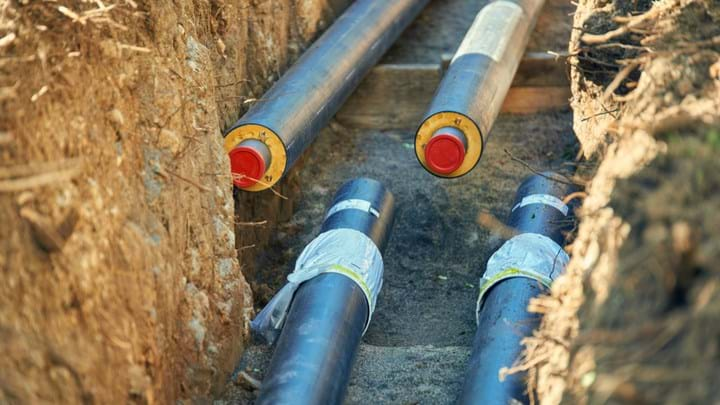UK heat network projects awarded £25m
FOUR heat network projects have been awarded almost £25m (US$31.6m) of funding, in the third round of the UK’s Heat Networks Investment Project (HNIP). Recipients include the first HNIP-funded mine water heating project, which could save 1,300 t/y of carbon dioxide (CO2) emissions.
Heat networks (also referred to as district heating) are distribution systems which deliver heat from a centralised source to a number of different buildings. They can be decarbonised more easily than other heat sources as new technologies can be added to systems with little disruption to individual households. The UK’s Department of Business, Energy and Industrial Strategy, expects heat networks will have a strong role to play in delivering low carbon heat to homes in the future.
The £320m HNIP funds projects in England and Wales. In previous funding rounds it provided about £39.2m to seven projects. With the newly-funded projects, the total funded network trench length has grown to 41.5 km.
The Gateshead Council was amongst the successful applicants of round three of HNIP funding, receiving about £5.9m. The council plans to use geothermal energy from an operational mine water treatment scheme to deliver heat to homes and buildings via an extension of the Gateshead District Energy Scheme. The scheme, which has been under development since 2011, is intended to serve the town centre and the Gateshead Quays area.
Gateshead will use the funding to commercialise and construct the first major strategic eastward expansion of the heat network within its district energy scheme.

The funding will go towards installing 5.5 km of new heating pipes to the east of the town centre to supply up to 12 GWh of affordable, low-carbon heat to as many as 1,250 homes and five additional buildings, including a care home and the town’s international stadium. Additionally, the council will install a 6 MW water source heat pump that will extract heat from water in underground mine workings, located about 150 m beneath the town centre.
According to Ken Hunnisett, Project Director at Triple Point Heat Networks Investment Management, the Gateshead network will deliver 1,300 t/y of CO2 emission savings over the first 15 years. Triple Point Heat Networks Investment Management is the partnership responsible for delivering HNIP.
The Gateshead Council is working closely with the UK’s Coal Authority, which manages disused mine workings under Gateshead, to ensure the project’s success. This is one of several project the Coal Authority is collaborating on in the north east of England.
John McElroy, Cabinet Member of the Gateshead Council, said: “This new proposal uses a source of energy that is already under our feet but which is virtually unused. Thanks to the continued development of heat pump technology, we are at last able to properly exploit this abundant untapped heat source and use it to warm thousands of homes and businesses in Gateshead. We have been looking at this proposal for some considerable time, so the award of this grant is timely and it means we can now begin to bring it to fruition.
“There must be hundreds of miles of abandoned mine workings beneath Gateshead and many of them are flooded, providing access to a sustainable source of heat, so there is huge scope for more initiatives like this. It is particularly satisfying that we can exploit the forgotten remains of an old industry – and a heavily polluting one at that – to create clean green energy.”
Jeremy Crooks, Head of Innovation at the Coal Authority, said: “This is a fantastic opportunity to repurpose the vast network of underground mine workings as a clean sustainable energy source attracting investment, creating jobs and tackling climate change, bringing exciting opportunities to communities previously disadvantaged by mine closures.”
Hunnisett commented: “Mine energy would seem to be ideally suited to district heating. At a time when we have great cause to reflect on our domestic resilience, the ability of our coalfields to provide clean, affordable, perpetually-renewing heat should be a source of great national pride… Interest in mine water energy as a heat source for district heating networks in England and Wales is strong and growing with other projects committed to using this invaluable natural resource already in our pipeline.
“In the days and weeks to come, we anticipate announcing details of the other projects who were successful in Round 3 including information on another exciting HNIP first.”
The details of other successful applicants have not yet been released to the public.
Modelling for the Committee on Climate Change carried out by energy consultancy Energy Element, projected that district heating could supply 18% of UK heat demand by 2050.
In May, Vattenfall announced that it would design a heat network to supply 10,500 homes in London, using heat captured from Cory Riverside Energy’s energy-from-waste plant. The company added that it would apply for HNIP funding to help fund deployment.
Mine water heating
Water in mines is heated by geothermal processes, providing a stable, perpetually renewing, and zero-carbon heat source that can be transferred by pipe networks using a heat exchanger – a system used to transfer heat between two or more fluids – and distributed to buildings. According to the Coal Authority, which works to resolve the impacts of mining, theoretically there is 2.2m GWh of annually renewing geothermal energy within mine workings. This is enough to heat 180m homes, 25 times more than are in the coalfields.
As 25% of UK homes and businesses are sited on former coalfields, the HNIP partnership expects that mine water energy could be an important energy source for district energy heating schemes.
Recent Editions
Catch up on the latest news, views and jobs from The Chemical Engineer. Below are the four latest issues. View a wider selection of the archive from within the Magazine section of this site.




